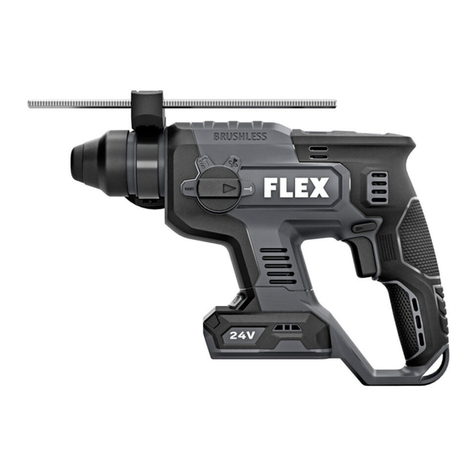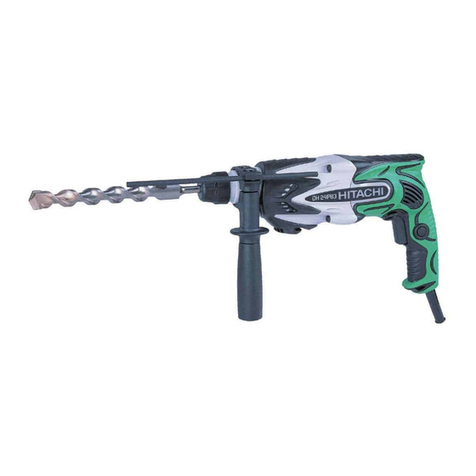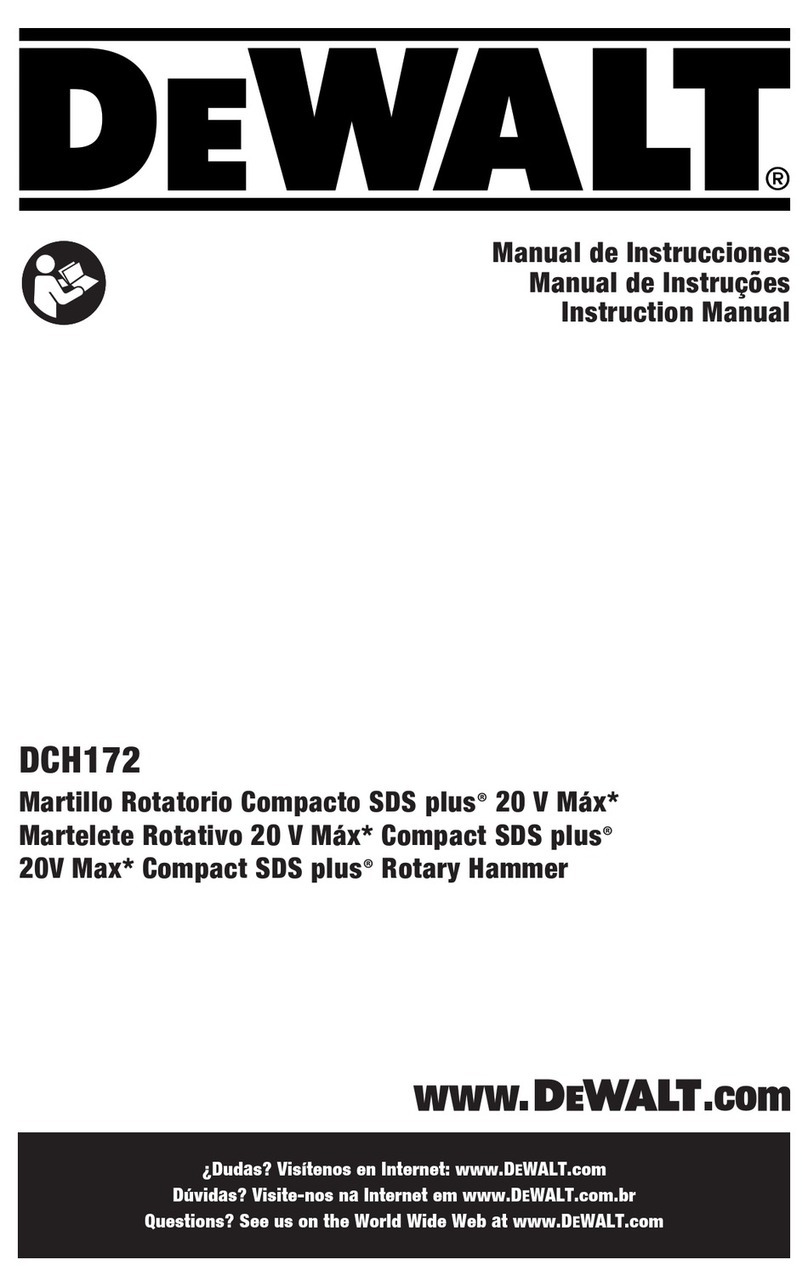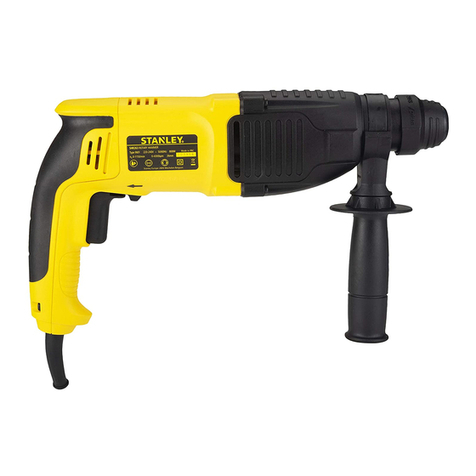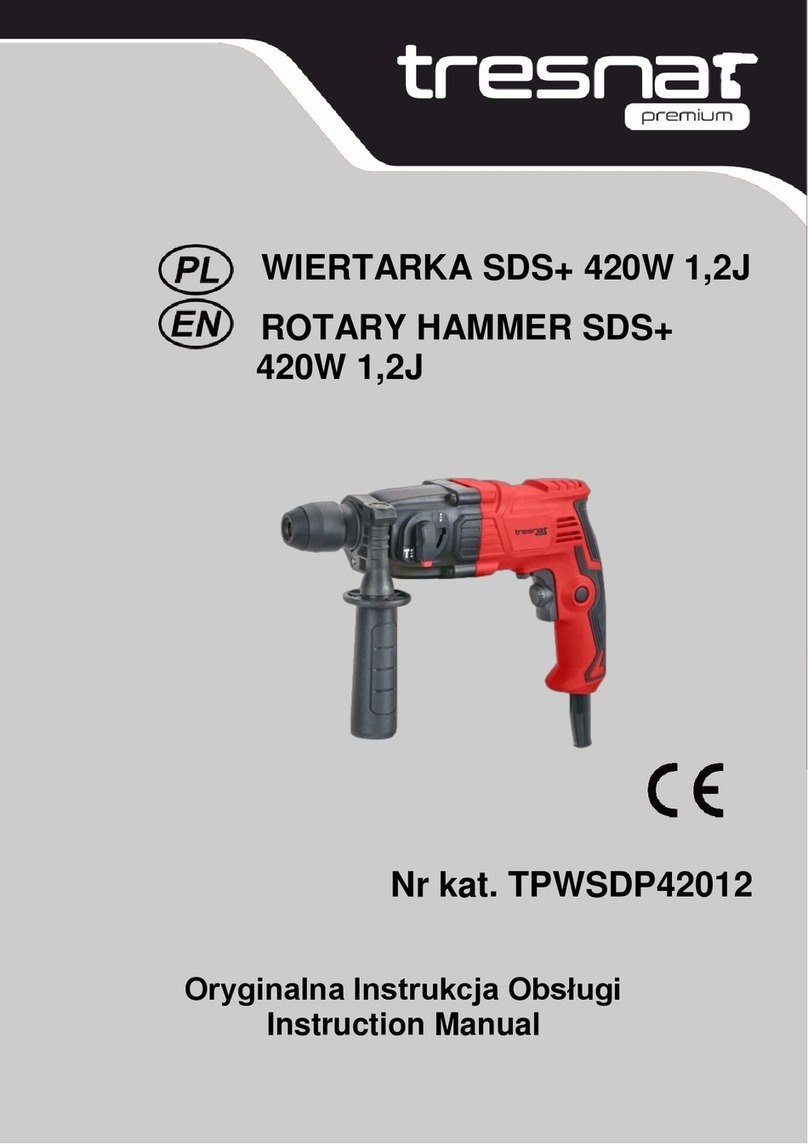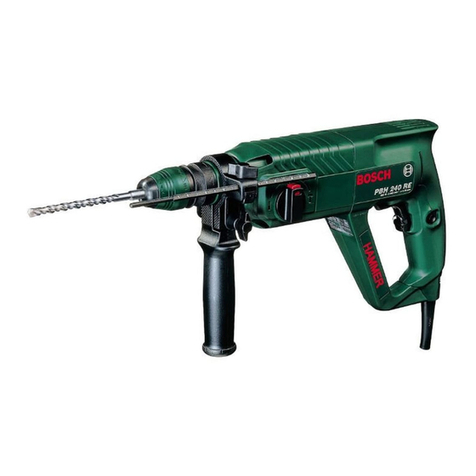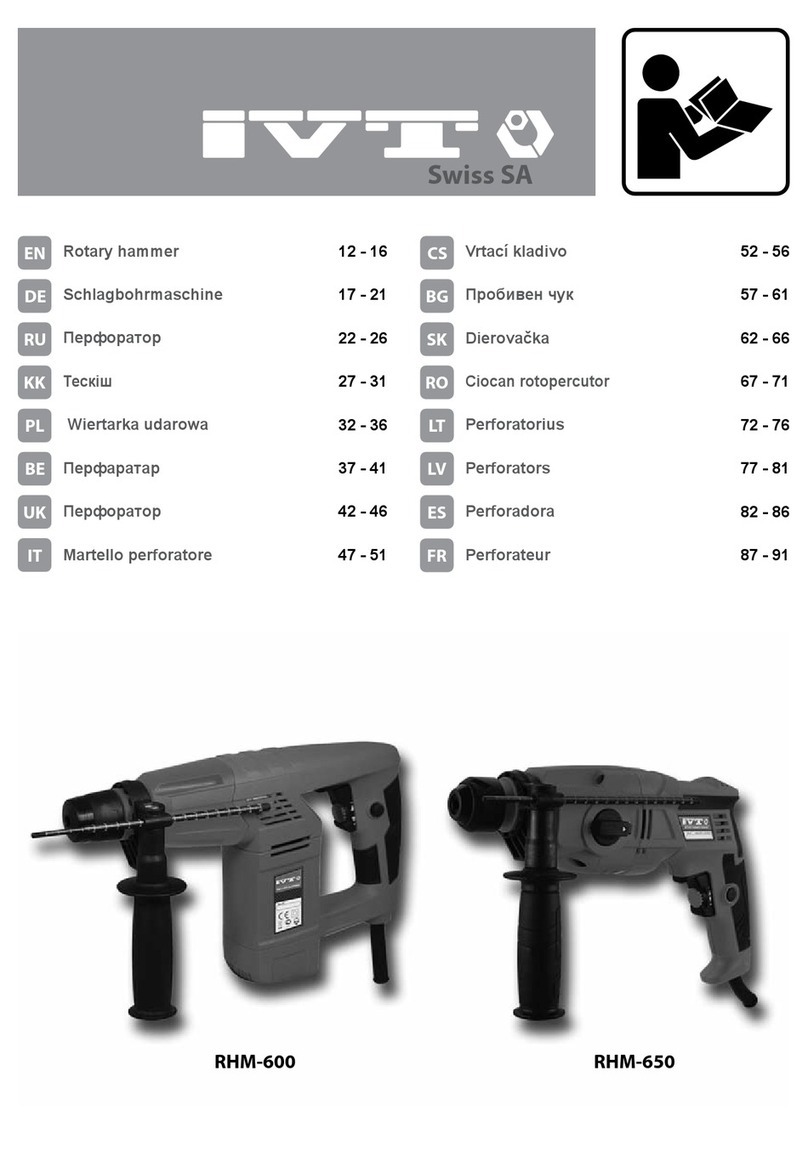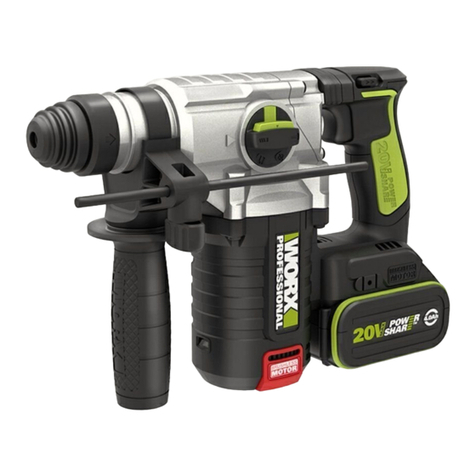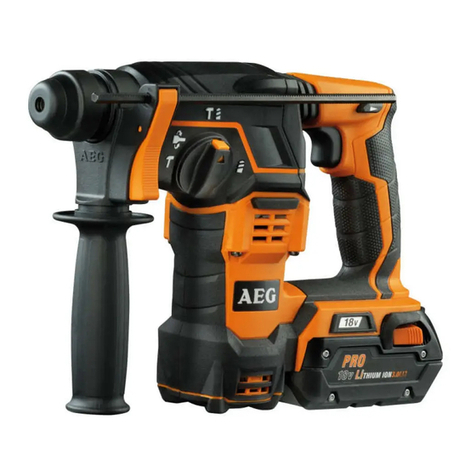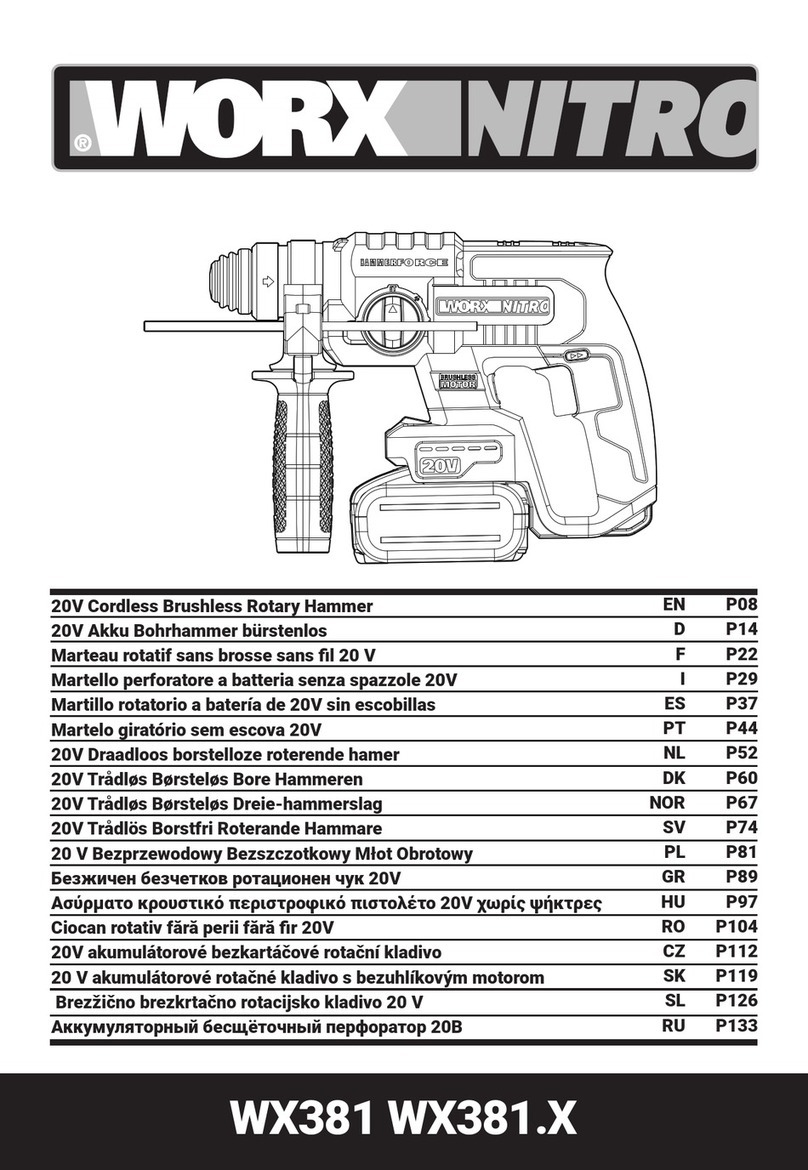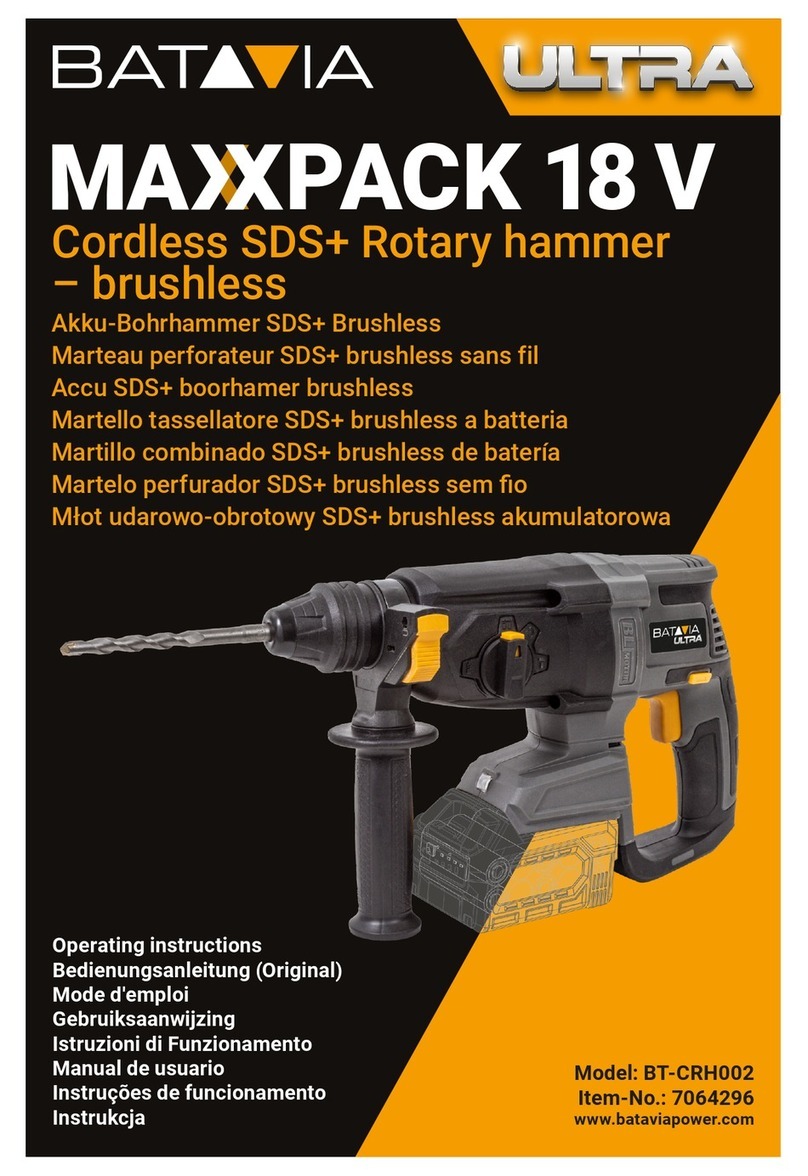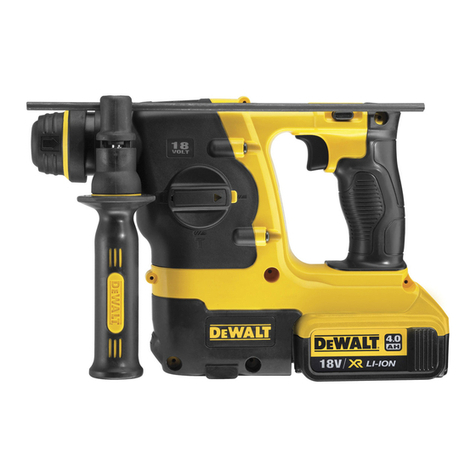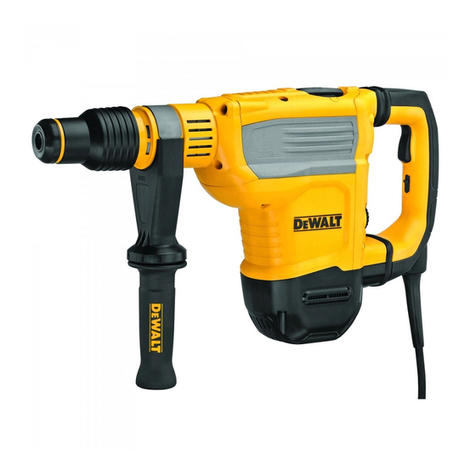Flex FX1551A User manual

For English
Version
See page 2
◆
Version
française
Voir page 21
◆
Versión en
español
Ver la página 41
Model:
Modelo:
Modèle:
OPERATOR’S MANUAL
MANUAL DEL OPERADOR
MANUEL DE L’UTILISATEUR
833-FLEX-496
(833-3539-496) www.Registermyex.com
Contact Us /
Nous contacter /
Contáctenos
24V 1" ROTARY HAMMER
MARTEAU ROTATIF DE 2,5 CM / 1 PO, 24 V
MARTILLO ROTATIVO DE 1 PULGADA DE 24 V
FX1551A

-2-
SAFETY SYMBOLS
The purpose of safety symbols is to attract your attention to possible dangers. The safety symbols
and the explanations with them deserve your careful attention and understanding. The symbol
warnings do not, by themselves, eliminate any danger. The instructions and warnings they give are
no substitutes for proper accident prevention measures.
WARNING Be sure to read and understand all safety instructions in this Owner's Manual,
including all safety alert symbols such as "DANGER," "WARNING," and
"CAUTION" before using this tool. Failure to follow all instructions listed below may result in electric
shock, re, and/or serious personal injury.
The denitions below describe the level of severity for each signal word. Please read the manual and
pay attention to these symbols.
This is the safety alert symbol. It is used to alert you to potential personal
injury hazards. Obey all safety messages that follow this symbol to avoid
possible injury or death.
DANGER DANGER indicates a hazardous situation which, if not avoided, will result in
death or serious injury.
WARNING WARNING indicates a hazardous situation which, if not avoided, could result
in death or serious injury.
CAUTION CAUTION, used with the safety alert symbol, indicates a hazardous situation
which, if not avoided, will result in minor or moderate injury.
Damage Prevention and Information Messages
These inform the user of important information and/or instructions that could lead to equipment or
other property damage if they are not followed. Each message is preceded by the word "NOTICE",
as in the example below:
NOTICE: Equipment and/or property damage may result if these instructions are not followed.
WARNING The operation of any power tools can result in foreign
objects being thrown into your eyes, which can result in
severe eye damage. Before beginning power tool operation, always wear
safety goggles or safety glasses with side shields and a full face shield when
needed. We recommend a Wide Vision Safety Mask for use over eyeglasses
or standard safety glasses with side shields. Always use eye protection which
is marked to comply with ANSI Z87.1.

-3-
GENERAL POWER TOOL SAFETY WARNINGS
WARNING Read all safety warnings, instructions, illustrations and specications
provided with this power tool. Failure to follow all instructions listed below may
result in electric shock, re and/or serious injury.
SAVE ALL WARNINGS AND INSTRUCTIONS FOR FUTURE REFERENCE.
The term "power tool" in the warnings refers to your mains-operated (corded) power tool or battery-
operated (cordless) power tool.
Work area safety
Keep work area clean and well lit. Cluttered
or dark areas invite accidents.
Do not operate power tools in explosive
atmospheres, such as in the presence of
ammable liquids, gases or dust. Power
tools create sparks which may ignite the dust or
fumes.
Keep children and bystanders away while
operating a power tool. Distractions can cause
you to lose control.
Electrical safety
Power tool plugs must match the outlet.
Never modify the plug in any way. Do
not use any adapter plugs with earthed
(grounded) power tools. Unmodied plugs
and matching outlets will reduce risk of electric
shock.
Avoid body contact with earthed or
grounded surfaces, such as pipes, radiators,
ranges and refrigerators. There is an
increased risk of electric shock if your body is
earthed or grounded.
Do not expose power tools to rain or wet
conditions. Water entering a power tool will
increase the risk of electric shock.
Do not abuse the cord. Never use the cord
for carrying, pulling or unplugging the
power tool. Keep cord away from heat, oil,
sharp edges or moving parts. Damaged or
entangled cords increase the risk of electric
shock.
When operating a power tool outdoors, use
an extension cord suitable for outdoor use.
Use of a cord suitable for outdoor use reduces
the risk of electric shock.
If operating a power tool in a damp location
is unavoidable, use a ground fault circuit
interrupter (GFCI) protected supply. Use of a
GFCI reduces the risk of electric shock.
Personal safety
Stay alert, watch what you are doing and
use common sense when operating a power
tool. Do not use a power tool while you are
tired or under the inuence of drugs, alcohol
or medication. A moment of inattention while
operating power tools may result in serious
personal injury.
Use personal protective equipment. Always
wear eye protection. Protective equipment
such as a dust mask, non-skid safety shoes,
hard hat or hearing protection used for appropriate
conditions will reduce personal injuries.
Prevent unintentional starting. Ensure
the switch is in the off-position before
connecting to power source and/or battery
pack, picking up or carrying the tool.
Carrying power tools with your nger on the
switch or energizing power tools that have the
switch on invites accidents.
Remove any adjusting key or wrench before
turning the power tool on. A wrench or a key
left attached to a rotating part of the power tool
may result in personal injury.
Do not overreach. Keep proper footing
and balance at all times. This enables
better control of the power tool in unexpected
situations.
Dress properly. Do not wear loose clothing
or jewelry. Keep your hair and clothing away
from moving parts. Loose clothes, jewelry or
long hair can be caught in moving parts.
If devices are provided for the connection
of dust extraction and collection facilities,
ensure these are connected and properly
used. Use of dust collection can reduce dust-
related hazards.
Do not let familiarity gained from frequent
use of tools allow you to become
complacent and ignore tool safety
principles. A careless action can cause severe
injury within a fraction of a second.

-4-
Power tool use and care
Do not force the power tool. Use the correct
power tool for your application. The correct
power tool will do the job better and safer at the
rate for which it was designed.
Do not use the power tool if the switch
does not turn it on and off. Any power tool
that cannot be controlled with the switch is
dangerous and must be repaired.
Disconnect the plug from the power
source and/or remove the battery pack,
if detachable, from the power tool before
making any adjustments, changing
accessories, or storing power tools. Such
preventive safety measures reduce the risk of
starting the power tool accidentally.
Store idle power tools out of the reach of
children and do not allow persons unfamiliar
with the power tool or these instructions
to operate the power tool. Power tools are
dangerous in the hands of untrained users.
Maintain power tools and accessories.
Check for misalignment or binding of
moving parts, breakage of parts and any
other condition that may affect the power
tool’s operation. If damaged, have the power
tool repaired before use. Many accidents are
caused by poorly maintained power tools.
Keep cutting tools sharp and clean. Properly
maintained cutting tools with sharp cutting
edges are less likely to bind and are easier to
control.
Use the power tool, accessories and
tool bits etc. in accordance with these
instructions, taking into account the working
conditions and the work to be performed.
Use of the power tool for operations different
from those intended could result in a hazardous
situation.
Keep handles and grasping surfaces dry,
clean and free from oil and grease.
Slippery handles and grasping surfaces do not
allow for safe handling and control of the tool in
unexpected situations.
Battery tool use and care
Recharge only with the charger specied by
the manufacturer. A charger that is suitable for
one type of battery pack may create a risk of re
when used with another battery pack.
Use power tools only with specically
designated battery packs. Use of any other
battery packs may create a risk of injury and
re.
When battery pack is not in use, keep it
away from other metal objects, like paper
clips, coins, keys, nails, screws or other
small metal objects, that can make a
connection from one terminal to another.
Shorting the battery terminals together may
cause burns or a re.
Under abusive conditions, liquid may be
ejected from the battery; avoid contact.
If contact accidentally occurs, ush with
water. If liquid contacts eyes, additionally
seek medical help. Liquid ejected from the
battery may cause irritation or burns.
Do not use a battery pack or tool that is
damaged or modied. Damaged or modied
batteries may exhibit unpredictable behavior
resulting in re, explosion or risk of injury.
Do not expose a battery pack or tool to
re or excessive temperature. Exposure to
re or temperature above 265 °F may cause
explosion.
Follow all charging instructions and do
not charge the battery pack or tool outside
the temperature range specied in the
instructions. Charging improperly or at
temperatures outside the specied range may
damage the battery and increase the risk of re.
Service
Have your power tool serviced by a
qualied repair person using only identical
replacement parts. This will ensure that the
safety of the power tool is maintained.
Never service damaged battery packs.
Service of battery packs should only be
performed by the manufacturer or authorized
service providers.

-5-
SAFETY WARNINGS FOR HAMMER
• Wear ear protectors when impact drilling.
Exposure to noise can cause hearing loss.
• Hold the power tool by insulated gripping
surfaces, when performing an operation
where the cutting tool may contact hidden
wiring. Cutting tools contacting a “live” wire
may make exposed metal parts of the power
tool “live” and could give the operator an
electric shock.
• Use auxiliary handle(s), if supplied with
the tool. Loss of control can cause personal
injury.
• Secure the work piece. Clamping devices or
a vise will hold the work piece in place better
and more safely than holding it by hand.
• Do not drill, fasten or break into existing
walls or other blind areas where electrical
wiring may exist. If this situation is
unavoidable, disconnect all fuses or circuit
breakers feeding this worksite.
• Position yourself to avoid being caught
between the tool or side handle and walls
or posts. Should the bit become bound or
jammed in the work, the reaction torque of the
tool could crush your hand or leg.
Safety instructions when using long
drill bits:
• Never operate at higher speed than the
maximum speed rating of the drill bit. At higher
speeds, the bit is likely to bend if allowed to
rotate freely without contacting the workpiece,
resulting in personal injury.
• Always start drilling at low speed and with the
bit tip in contact with the workpiece.
• At higher speeds, the bit is likely to bend if
allowed to rotate freely without contacting the
workpiece, resulting in personal injury.
• Apply pressure only in direct line with the bit
and do not apply excessive pressure. Bits
can bend causing breakage or loss of control,
resulting in personal injury.
WARNING
• Some dust created by power sanding, sawing,
grinding, drilling and other construction
activities contains chemicals known to the
State of California to cause cancer, birth
defects or other reproductive harm. Some
examples of these chemicals are:
– Lead from lead-based paints.
– Crystalline silica from bricks, cement, and
other masonry products.
– Arsenic and chromium from chemically-treated
lumber.
• Your risk from these exposures varies,
depending upon how often you do this type
of work. To reduce your exposure to these
chemicals:
– Work in a well-ventilated area.
– Work with approved safety equipment, such
as dust masks that are specially designed to
lter out microscopic particles.
– Avoid prolonged contact with dust from power
sanding, sawing, grinding, drilling, and other
construction activities. Wear protective clothing
and wash exposed areas with soap and water.
Allowing dust to get into your mouth or eyes or
to lie on the skin may promote absorption of
harmful chemicals.

-6-
SYMBOLS
IMPORTANT: Some of the following symbols may be used on your tool. Please study them and
learn their meaning. Proper interpretation of these symbols will allow you to operate the tool better
and safer.
Symbol Name Designation/Explanation
V Volts Voltage
A Amperes Current
Hz Hertz Frequency (cycles per second)
W Watt Power
kg Kilograms Weight
min Minutes Time
s Seconds Time
Wh Watt-hours Battery capacity
Ah Ampere-hours Battery capacity
ø Diameter Size of drill bits, grinding wheels, etc.
n0No load speed Rotational speed, at no load
n Rated speed Maximum attainable speed
…/min Revolutions or reciprocations per
minute (rpm)
Revolutions, strokes, surface speed, orbits,
etc. per minute
O Off position Zero speed, zero torque...
1,2,3,…
I,II,III, Selector settings Speed, torque, or position settings. Higher
number means greater speed
Innitely variable selector with off Speed is increasing from 0 setting
Arrow Action in the direction of arrow
Alternating current (AC) Type or a characteristic of current
Direct current (DC) Type or a characteristic of current
Alternating or direct current
(AC / DC) Type or a characteristic of current
Class II tool Designates Double Insulated Construction
tools.
Protective earth Grounding terminal
Li-ion RBRC seal Designates Li-ion battery recycling
program
Read the instructions Alerts user to read manual

-7-
Symbol Name Designation/Explanation
Wear eye protection symbol Alerts user to wear eye protection
Always operate with two hands Alerts user to always operate with two
hands
Do not use the guard for cut-off
operations Do not use the guard for cut-off operations
SYMBOLS (CERTIFICATION INFORMATION)
Symbol Designation/Explanation
This symbol designates that this tool is listed by Underwriters Laboratories.
This symbol designates that this component is recognized by Underwriters
Laboratories.
This symbol designates that this tool is listed by Underwriters Laboratories, to
United States and Canadian Standards.
This symbol designates that this tool is listed by the Canadian Standards
Association.
This symbol designates that this tool is listed by the Canadian Standards
Association, to United States and Canadian Standards.
This symbol designates that this tool is listed by the Intertek Testing Services,
to United States and Canadian Standards.

-8-
FUNCTIONAL DESCRIPTIONS AND SPECIFICATIONS
Rotary Hammer
Fig. 1
SDS-plus
Chuck
Dust Cap
Detachable Chuck Direction-of-Rotation
(forward/center-lock/
reverse) Selector
Auxiliary Handle
Detachable
Keyless 3-jaw
Chuck
Quick Clamp
Depth Rod
LED LightRelease
Button
Mode Selector
Variable-Speed
Trigger Switch
Vibration Damper
Model No. FX1551A
Rated Voltage 24 V d.c.
Chuck size/type SDS-plus
No-load Speed 0-980 /min (RPM)
Impact Rate 0-4350 /min (IPM)
Recommended working temperature -4 – 104°F (-20 – 40°C)
Recommended storage temperature < 122°F (< 50°C)

-9-
ASSEMBLY
WARNING Detach the battery pack
from the tool before
performing any assembly or adjustments, or
changing accessories. Such preventive safety
measures reduce the risk of starting the tool
accidentally.
TO ATTACH/DETACH BATTERY PACK
(FIG. 2)
Lock “OFF” the variable-speed trigger switch
on the tool by placing the direction-of-rotation
(forward/center-lock/reverse) selector in the
center position before attaching or detaching
the battery pack.
a. To attach the battery pack:
Align the raised rib on the battery pack with the
grooves in the tool, and then slide the battery
pack onto the tool.
NOTICE: WWhen attaching the battery
pack to the tool, be sure that the raised rib
on the battery pack aligns with the groove
inside the tool and that the latches snap into
place properly. Improper attachment of the
battery pack can cause damage to internal
components.
b. To detach the battery pack:
Depress the battery-release button located
on the front of the battery pack to release the
battery pack. Pull the battery pack out and
remove it from the tool.
WARNING Battery tools are always in
operating condition.
Therefore, the direction-of-rotation (forward/
center-lock/reverse) selector should always
be locked in the center position when the
tool is not in use or while carrying the tool at
your side.
WARNING Do not attempt to modify
this tool or create
accessories not recommended for use with
this tool. Any such alteration or modication is
misuse and could result in a hazardous
condition leading to possible serious injury.
INSTALLING AND REMOVING ACCESSORIES
WARNING Do not use bits with
damaged shanks.
Your tool is equipped with an SDS-plus chuck
that accepts SDS-plus accessories only. Lock the
trigger switch “OFF” on the tool by placing the
direction-of-rotation selector in the center position.
To install the accessory (Fig. 3):
– Clean the accessory and lightly lubricate it
before inserting it into the chuck.
– Insert the accessory in the SDS-plus chuck
while turning and pushing it until it engages.
The accessory locks in position automatically.
– Check to ensure that the accessory is locked
in place.
Fig. 2
Battery-Release Button
Fig. 3
SDS-plus Chuck
Attach Detach

-10-
To remove the accessory (Fig. 4):
WARNING Use protective gloves
when removing the bit
from the tool, or rst allow the bit to cool
down. The bit may be hot after prolonged use.
– Pull back the locking sleeve and remove the
accessory from the chuck.
CHANGING THE DETACHABLE CHUCK
The detachable chuck can be easily exchanged.
To remove the detachable chuck (Fig. 5):
Grasp the locking ring and pull it away from the
tool. Remove the chuck from the tool.
To install the detachable keyless chuck
(Fig. 6):
The SDS-plus chuck can be replaced with the
detachable keyless 3-jaw chuck.
Grasp the locking ring of the 3-jaw chuck and
pull it in the direction away from the tool.
Place the 3-jaw chuck on the spindle of the tool.
The four steel balls within the chuck should be
aligned with the ball pits on the spindle.
The 3-jaw chuck is properly installed when the
“click” can clearly be heard and the locking ring
is directly locked in place.
Fig. 5
Locking Ring
Fig. 6
2
1
Fig. 4
Locking Sleeve

-11-
AUXILIARY HANDLE (FIG. 7)
The tool must be supported with the auxiliary
handle, which can be swiveled 360°.
To reposition and/or swivel the handle, rotate
hand grip to loosen it, move the handle to the
desired position, and securely retighten the
hand grip.
WARNING For safety and ease of
operation, securely tighten
the auxiliary handle by turning the handle
clockwise before every use.
DEPTH ROD (FIG. 8)
a. Depress the upper part of the quick clamp and
then insert the depth rod through the opening.
b. Set the depth rod to the desired drilling depth.
c. Release the quick clamp to lock the depth rod
in position.
Fig. 7
Auxiliary Handle
Fig. 8
Depth Rod
Quick Clamp

-12-
ADJUSTMENTS
DIRECTION-OF-ROTATION (FORWARD/
CENTER-LOCK/REVERSE) SELECTOR (FIG. 9)
WARNING After tool use, lock the
direction-of-rotation
selector in the “OFF” position (center-lock)
to help prevent accidental starts and
possible injury.
Your tool is equipped with a direction-of-rotation
selector, located above the variable-speed
trigger switch. This selector is used to change
the direction of rotation of the bit and to lock the
variable-speed trigger in the “OFF” (center-lock)
position.
a. Position the direction-of-rotation selector to
the far left of the tool to drill holes (Fig. 9).
b. Position the direction-of-rotation selector to
the far right of the tool to remove drill bit from
holes (Fig. 9).
c. Position the switch in the “OFF”
(center-lock) position to help reduce the
possibility of accidental starting when not in
use.
NOTICE: To prevent gear damage, always
allow the tool to come to a complete stop before
changing the direction of rotation.
NOTICE: The tool will not run unless the
direction-of-rotation selector is engaged fully to
the left or to the right.
LED LIGHT (FIG. 10)
Your tool is equipped with an LED light, located
on the base of the tool. This provides additional
light on the surface of the workpiece for
operation in lower-light areas.
The LED light will automatically turn on with
a slight squeeze of the variable-speed trigger
switch before the tool starts running and will turn
off approximately 10 seconds after the
variable-speed trigger switch is released.
The LED light will rapidly ash when the tool
and/or battery pack becomes overloaded or too
hot, and the internal sensors will turn the tool
off. Rest the tool for a while or place the tool
and battery pack separately under air ow to
cool them.
The LED light will ash more slowly to indicate
that the battery is at low-battery capacity.
Recharge the battery pack.
Fig. 9
Fig. 10
LED Light

-13-
VIBRATION DAMPER (FIG. 11)
The vibration damper provides the operator
with comfort without sacricing power or
performance.
Ideal force applied to the handle by the operator
compresses the vibration damper slightly and
allows the tool to work aggressively while the
handle remains steady.
Excessive force applied to the handle
compresses the vibration damper signicantly
and does not reduce the vibration efciently.
Operators will be able to feel the difference
and should adjust the force to the handle
accordingly.
Fig. 11
Vibration Damper

-14-
OPERATING INSTRUCTIONS
WARNING If any parts are damaged
or missing, do not operate
this product until the parts are replaced. Use
of this product with damaged or missing parts
could result in serious personal injury.
VARIABLE-SPEED TRIGGER SWITCH
(FIG. 12)
Your tool is equipped with a variable-speed
trigger switch. The tool can be turned "ON" or
"OFF" by depressing or releasing the variable-
speed trigger switch.
The variable-speed trigger switch delivers higher
speed with increased trigger pressure and lower
speed with decreased trigger pressure.
WARNING To prevent accidental
starting that could cause
serious personal injury, always remove the
battery pack from the tool when assembling
parts.
This rotary hammer must be used only with
the battery packs and chargers listed below:
Battery Pack Charger
2.5Ah 5Ah 8Ah 12Ah 150W 280W
FLEX FX0111 FLEX FX0121 FLEX FX0221 FLEX FX0231 FLEX FX0411 FLEX FX0421
NOTICE: Please refer to the battery pack and charger manuals for detailed operating
information.
Fig. 12
Variable-Speed
Trigger Switch

-15-
MODE SELECTOR (FIG. 13)
The operation of the gearbox for each
application is set with the mode selector. To
change among functions, depress the release
button and rotate the selector to the desired
operating mode.
NOTICE: Do not operate the mode selector
until the tool comes to a complete stop.
Changing mode during rotation of the chuck can
cause damage to the tool.
Rotary Drilling Mode
Hammer Drilling Mode
Working Angle
Adjustment for Chisel
Bits
Hammering Mode
SETTING THE CHISEL POSITION (FIG. 14)
The chisel can be turned to a position that is
ideal for the work to be performed.
a. Move the mode selector to the symbol .
b. Turn the chisel until it is at the required angle.
c. Move the mode selector to the symbol .
Make sure that it audibly clicks into place.
Fig. 13
Mode Selector
Release
Button
b
ac
Fig. 14

-16-
DRILLING MASONRY
(HAMMER DRILLING MODE)
For maximum performance, use carbide-tipped
masonry bits when drilling holes in brick,
concrete, etc. and set the mode selector to the
hammer drilling mode .
a. Maintain a speed and a pressure that allow
cutting without overheating the bit or drill.
Applying too much pressure will:
– Overheat the tool.
– Wear the bearings.
– Bend or burn bits.
– Produce off-center or irregular-shaped holes.
b. Apply light pressure and medium speed for
best results in brick.
c. Apply additional pressure for hard materials,
such as concrete.
d. Begin drilling at a very low speed to prevent
the bit from slipping off the starting point.
USING KEYLESS 3-JAW CHUCK
(FIG. 15)
The keyless 3-jaw chuck lets you use a variety
of straight shank bits with this tool.
NOTICE: The tool must be set to the Rotary Drilling
mode when using the 3-jaw chuck! Using the tool in
Hammering mode can cause damage to the 3-jaw
chuck and may cause bits to become loose and
cause damage or injury.
a. Disconnect the battery pack and lock the
trigger switch “OFF” on the tool by placing
the direction-of-rotation selector in the center
position.
b. Attach the keyless 3-jaw chuck as described
in “CHANGING THE DETACHABLE CHUCK”
chapter earlier.
c. Turn the sleeve of the 3-jaw chuck to open
the jaws on the chuck wide enough to t a drill
bit.
d. For small bits – insert the bit up to the utes.
For large bits – insert the bit as far as it will
go.
e. Securely lock the bit in place by tightening the
chuck sleeve.
f. Set the mode selector to rotary drilling!
g. Attach the battery pack and start drilling.
c
e
d
Fig. 15

-17-
DRILLING
WARNING Always wear safety
goggles or safety glasses
with side shields during power tool
operation or when blowing dust. If operation
is dusty, also wear a dust mask.
a. Check that the direction-of-rotation selector is
at the correct setting (forward or reverse).
b. Secure the material to be drilled in a vise or
with clamps to keep it from turning as the drill
bit rotates.
c. Hold the drill rmly and place the bit at the
point to be drilled.
d. Depress the variable-speed trigger switch to
start the drill.
e. Move the drill bit into the workpiece, applying
only enough pressure to keep the bit “biting”.
Do not force the drill or apply side pressure to
elongate a hole. Let the tool do the work.
f. When drilling hard, smooth surfaces, use a
center punch to mark the desired location of
the hole. This will prevent the drill bit from
slipping off-center as the hole is started.
g. When drilling metals, use light oil on the drill
bit to keep it from overheating. The oil will
prolong the life of the bit and increase the
drilling efciency.
h. If the bit jams in the workpiece or if the drill
stalls, stop the tool immediately. Remove the
bit from the workpiece and determine the
reason for jamming.
There are two rules for drilling hard materials.
First, the harder the material, the greater the
pressure you need to apply to the tool. Second,
the harder the material, the slower the speed
should be. If the hole to be drilled is fairly large,
drill a smaller hole rst, and then enlarge to the
required size with a larger bit; it’s often faster in
the long run.
DRILLING WOOD (ROTARY DRILLING MODE)
(FIG. 16)
For maximum performance, use high-speed
steel or brad-point bits for wood drilling, and set
the mode selector to the rotary drilling mode .
a. Begin drilling at a very low speed to prevent
the bit from slipping off the starting point.
b. Increase speed as the drill bit bites into the
material.
c. When drilling “through” holes, place a block of
wood behind the workpiece to prevent ragged
or splintered edges on the back side of the
hole (Fig. 16).
NOTICE: Bits may overheat unless pulled out
frequently to clear chips from utes.
Fig. 16

-18-
DRILLING METAL
(ROTARY DRILLING MODE)
For maximum performance, use high-speed
steel bits for drilling metal or steel, and set the
mode selector to the rotary drilling mode .
a. When drilling metals, use light oil on the drill
bit to keep it from overheating. The oil will
prolong the life of the bit and increase the
drilling action.
b. Begin drilling at a very low speed to prevent
the bit from slipping off the starting point.
c. Maintain a speed and a pressure that allow
cutting without overheating the bit. Applying
too much pressure will:
– Overheat the tool.
– Wear the bearings.
– Bend or burn bits.
– Produce off-center or irregularly shaped holes.
DRILLING TILE (ROTARY DRILLING MODE)
(FIG. 17)
For maximum performance, use high-speed
steel bits for drilling in tile, and set the mode
selector to the rotary drilling mode.
a. When drilling holes in tile, practice on a
scrap piece to determine the best speed and
pressure. Set the tool to rotary drilling mode.
b. Begin drilling at a very low speed to prevent
the bit from slipping off the starting point.
NOTICE: Fig. 17 shows some tips for different
drilling operations.
DUST EXTRACTION
To reduce exposure to silica dust when
hammer-drilling in concrete and masonry, use
this rotary hammer with FLEX Dust Extraction
Attachment model FT151 connected to FLEX
Dust Extractor / Vacuum model FX5221 (both
sold separately) or other dust extractor with
99% or greater efciency.
Refer to the manual for FLEX FT151 for more
information.
Use a HEPA-ltered dust extractor / vacuum
when cleaning holes.
Fig. 17
Fig. 18
FT151

-19-
MAINTENANCE
WARNING To avoid serious personal
injury, always remove the
battery pack from the tool when cleaning or
performing any maintenance.
SERVICE
WARNING Preventive maintenance
performed by
unauthorized personnel may result in
misplacing of internal wires and
components which could cause a serious
hazard. We recommend that all tool service be
performed by a FLEX Factory Service Center or
Authorized FLEX Service Station.
GENERAL MAINTENANCE
WARNING When servicing, use only
identical replacement
parts. Use of any other parts could create a
hazard or cause product damage. Periodically
inspect the entire product for damaged, missing,
or loose parts such as screws, nuts, bolts, caps,
etc. Tighten securely all fasteners and caps and
do not operate this product until all missing or
damaged parts are replaced. Please contact
customer service or an authorized service
center for assistance.
CLEANING
WARNING The tool may be cleaned
most effectively with
compressed dry air. Always wear safety
goggles when cleaning tools with
compressed air. Ventilation openings and
switch levers must be kept clean and free of
foreign matter. Do not attempt to clean by
inserting pointed objects through openings.
WARNING Certain cleaning agents
and solvents damage
plastic parts. Some of these are: gasoline,
carbon tetrachloride, chlorinated cleaning
solvents, ammonia and household detergents
that contain ammonia.
STORAGE
Store the tool indoors in a place that is
inaccessible to children. Keep away from
corrosive agents.
ACCESSORIES
WARNING The use of any other accessories not specied in this manual may create a
hazard.
Depth rod
Auxiliary handle
Detachable keyless 3-jaw chuck

-20-
FLEX 5 YEAR LIMITED WARRANTY
Chervon North America, Inc. ("Seller") warrants to the original purchaser only, that all FLEX 24V
products will be free from defects in material or workmanship for a period of ve years from date of
purchase when the original purchaser registers the product within 30 days from the date of original
retail purchase and retains their receipt as proof of purchase. THE 5-YEAR LIMITED WARRANTY
PERIOD IS CONDITIONED ON REGISTRATION OF THE PRODUCT WITHIN 30 DAYS OF
PURCHASE AND ONLY APPLICABLE TO FLEX 24V TOOLS, BATTERIES AND CHARGERS. If
the original purchaser does not register their product within 30 days, the foregoing limited warranty
will apply for a duration of three years. Product registration can be completed online at
www.registermyex.com.
24V Tools: 5-Year Limited Warranty with Registration
24V Batteries and Chargers: 5-Year Limited Warranty with Registration
Corded, 12V and 20V FLEX Legacy Products: 1-Year Limited Warranty, No Registration Benet
Accessories and Attachments: No Warranty
SELLER’S SOLE OBLIGATION AND YOUR EXCLUSIVE REMEDY under this 5-Year Limited
Warranty and, to the extent permitted by law, any warranty or condition implied by law, shall be
the repair or replacement of parts, without charge, which are defective in material or workmanship
and which have not been misused, carelessly handled, or repaired by persons other than a FLEX
Authorized Service Dealer. This warranty does not cover part failure due to normal wear and tear.
To make a claim under warranty, return the complete product, transportation prepaid, to any FLEX
Authorized Service Dealer. For Authorized FLEX Service Dealers, please visit www.registermyex.
com or call 1-833-FLEX-496 (1-833-353-9496).
This 5-Year Limited Warranty does not apply to accessories, attachments or parts.
Any implied warranties applicable to a product shall be limited in duration equal to the duration of the
express warranties applicable to such product, as set forth in the rst paragraph above. Some states
in the U.S. and some Canadian provinces do not allow limitations on how long an implied warranty
lasts, so the above limitation may not apply.
FLEX is not responsible for direct, indirect, incidental or consequential damages. Some U.S. states
and Canadian provinces do not allow limitations on how long an implied warranty lasts and/or do
not allow the exclusion or limitation of incidental or consequential damages, so the above limitations
or exclusions may not apply. This limited warranty gives you specic legal rights, and you may also
have other rights which vary by state in the U.S. and by province in Canada.
This limited warranty applies only to products sold within the United States of America, Canada and
the commonwealth of Puerto Rico. For warranty coverage within other countries, contact your local
FLEX dealer.
© Chervon North America, 1203 E. Warrenville Rd., Naperville, IL 60563
www.expowertools.com
www.registermyex.com
1-833-FLEX-496 (1-833-353-9496)
Table of contents
Languages:
Other Flex Rotary Hammer manuals
